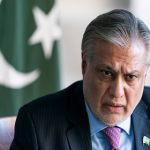After stalling for over a year, Pakistan has had to finally reveal uncomfortable truths about its economy to the International Monetary Fund (IMF), to qualify for the fund’s $3 billion bailout.
On 18th July, the IMF published a detailed report on Pakistan which gives a clearer picture of the country’s economy. Pakistan owes a staggering $30 billion – 30% of its entire foreign debt – to China, a figure both the governments have refused to share in the past. In fact, the country’s economy is in worse shape than what official statistics show, indicating they have been “managed.”
It now turns out that Pakistan owes $29.6 billion to China in various forms, accounting for an estimated 30% of its external debt. This is almost equal to the combined loans extended to Pakistan by the ADB and the World Bank and is four times the total loans from the Paris Club. Past work by Gateway House reveals that the interest rates on Chinese loans are higher than those on loans from the multilateral bodies or the Paris Club members. Many of these loans were contracted to finance the China Pakistan Economic Corridor, which was supposed to transform Pakistan but has instead left in economically shackled.
The report is a fund of knowledge on Pakistan’s hidden finances. It details the government’s attempts to manipulate exchange rates – actions the Fund explicitly advises against. The extent of Pakistan’s misleading statistics is dramatic. The IMF expects Pakistan’s GDP to decline by 0.5% during 2022-23 (FY23), as against a growth of 0.3% projected officially by the Pakistan Bureau of Statistics. However, given that Pakistan’s diesel and petrol consumption declined by 28% and 17% during FY23, both these numbers for GDP growth look optimistic. The slowdown in the economy is probably greater. Should sustained policy and reform implementation endure in Pakistan, the IMF projects economic growth at 2.5% for the next year, and a gradual increase to 5% over the medium term. Given Pakistan’s history in implementing IMF’s proposals, 5% is a difficult reach.
The IMF sees exceptionally high internal and external risks to Pakistan’s economic prospects. The report has a detailed description of Pakistan’s forex policies, and its attempts to massage the exchange rates. As reserves started to fall in late 2022, the government ‘persuaded’ the’ banks to keep the exchange rate stable, but without providing any forex at official prices. Likewise, the government didn’t permit banks to provide letters of credit for imports, effectively blocking imports – but this was done informally. This created a parallel (black) market for the dollar and other hard currencies, where these currencies traded at a higher price compared to the official rate. As a result, many imports dependent industries shut down, and inward remittances of foreign exchange also fell, as people could get a better rate for dollars in the open market.
Pakistan has now undertaken not to impose import restrictions to protect its forex reserves, as a part of its agreement with the IMF.
One of the conditions imposed by the IMF has been an increase in energy (electricity and gas) prices charged to consumers – necessary to address the continuing crisis of Pakistan’s energy sector of Pakistan. Unpaid dues to the electricity distribution companies are referred to as circular debt. Circular debt has a cascade effect as distribution companies are unable to pay the generation companies who in turn are unable to pay the fuel importers. The circular debt of Pakistan’s power sector has reached a historical high of 3% of the GDP. In case of natural gas, a fuel used by households and industry, the Fund doesn’t have full information, but believes that the circular debt is on a par with the power sector. The fund recommends regular tariff adjustments to reflect the actual energy costs for both of these sectors. Pakistan’s electricity regulator has therefore just revised upwards the base tariffs by PKR 5/unit for 2023-24. In the past, Pakistani government has often reversed these hikes, fearing voter anger. Whether the current regime stays the course remains to be seen.
Overall, the long-term economic mismanagement is also reflected in Pakistan’s budget figures. As per the IMF, two-thirds of Pakistan’s tax receipts are now directed to paying interest on domestic and foreign loans. The official military budget accounts for another 20% of tax receipts, leaving little for social and development spending.
To get out of the economic morass it is in, the country will have to undertake serious reforms – reducing subsidies, expanding the tax base and privatizing state owned enterprises downsizing the military – that will hurt existing vested interests and may cause short term pain. The hybrid regime of Pakistan has so far focused on the interests of its elite. Can it be compassionate and focus on its ordinary people?
Amit Bhandari is Senior Fellow for Energy, Investment and Connectivity, Gateway House.
This blog was exclusively written for Gateway House: Indian Council on Global Relations. You can read more exclusive content here.
For permission to republish, please contact outreach@gatewayhouse.in.
Support our work here.
©Copyright 2023 Gateway House: Indian Council on Global Relations. All rights reserved. Any unauthorised copying or reproduction is strictly prohibited.


